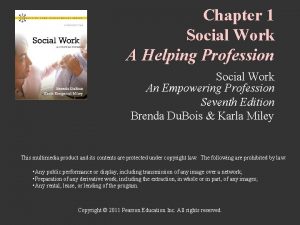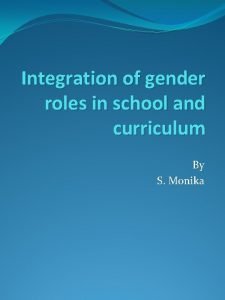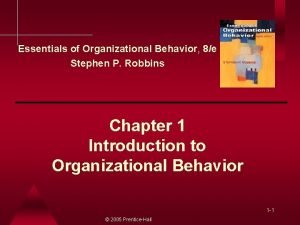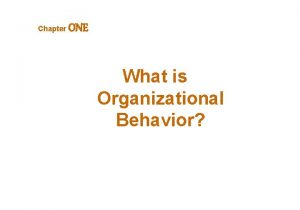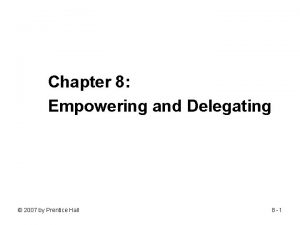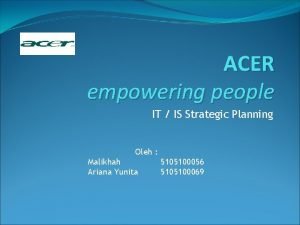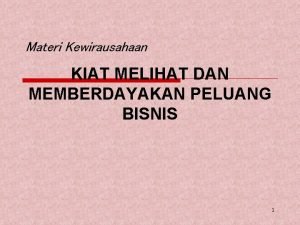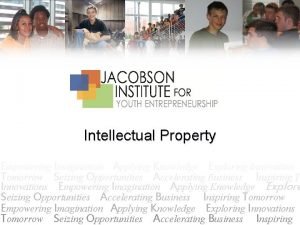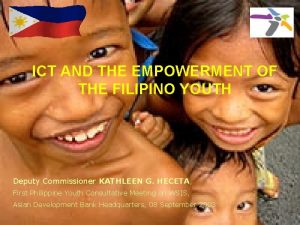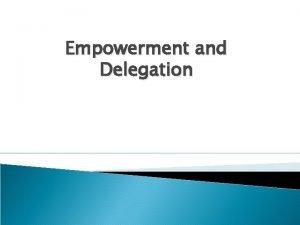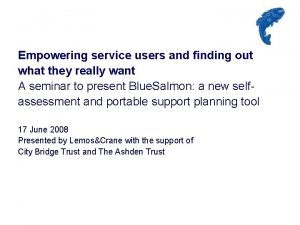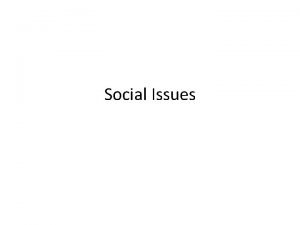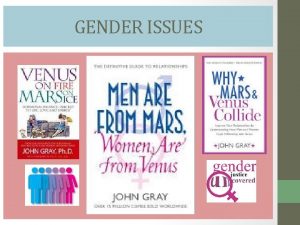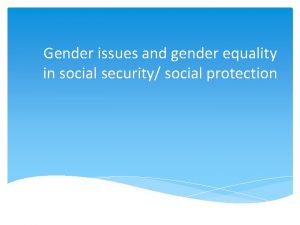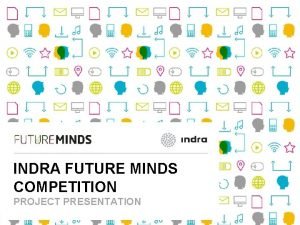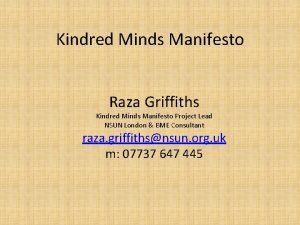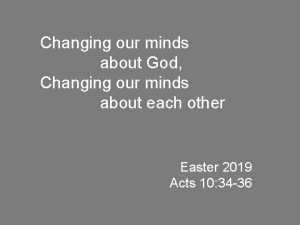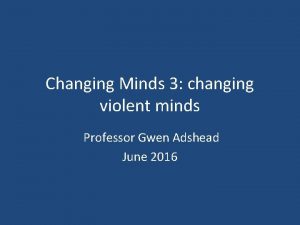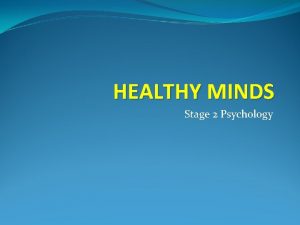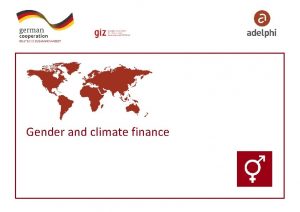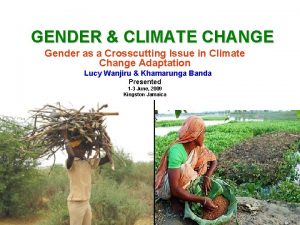Social Issues Empowering Minds Creating Opportunities Gender Issue

















- Slides: 17

Social Issues Empowering Minds. Creating Opportunities.

Gender Issue Ø Patriarchal society - Men hold authority over female family members and inherit family property and title Ø Son preference - Higher economic utility, Religious practices and Funeral rights Ø Discrimination Against girls - Medical treatment of illnesses, Nutritional discrimination Ø Dowry - Girls are a burden on families, Dowry Prohibition Act 1961, 498 a of the Indian Penal Code (IPC) Ø Sex-Selective Abortion - Pre-conception and Pre-natal Diagnostics Technique Act in 1994(Sex Ratio 0 -6 Years Age – 914/1000) Ø Literacy - literacy rate of females is 65. 46%. Ø Gender-based violence – Rape ( National Crime Records Bureau 2013 annual report), Marital rape, Rape of minors, Honor Killing. Mathura Rape Case. Empowering Minds. Creating Opportunities.

Ideological Framework Ø Maturity of Civilization Ø Atrocities – Dalit Women, Widows and NRI Husband Ø Child Prostitution, Human Trafficking Ø Social Stigma – Self Justification Ø Moral Policing – Mangalore Pub Ø Ethics and Morality Ø Caste Conflict Ø Consumerist Lifestyle Empowering Minds. Creating Opportunities.

India’s Solution Year Act 1956 Immoral Traffic 1961 Dowry Prohibition 1987 Sati 1990 National Commission For Women 2000 Juvenile Justice 2005 Domestic Violence 2006 Child Marriage 2009 Right to education act 2012 Protection of children from sexual offenses. bill passed in both houses. brief summary given on prsindia. org Empowering Minds. Creating Opportunities.

Schemes -Women and Girls Ø Beti bachao, Beti padhao" and "Sukanya Samriddhi account“ Ø Beijing platform for action - Fourth World Conference on Women held in Beijing in ’ 95 Ø CEDAW- Convention on the elimination of discrimination against women by UN Ø Central social welfare board under Ministry of Women and child Development Ø Ujjawala - Includes Rescue, Rehabilitation, Re-Integration and Repatriation for the victims Ø Justice Usha Mehra Committee - identify lapses on the part of public authorities and suggest measures to improve the safety and security of women in the capital Ø Justice JS Verma - to review existing laws and examine levels of punishment in cases of aggravated sexual assault and it has submitted its recommendations Ø Gender Budgeting – Since 2005 Empowering Minds. Creating Opportunities.

Specific Problem Prostitution in India: Disturbing numbers 7 lakh “Registered” sex workers in India (Health ministry, 2012) 40% Of them are underage (Study by Women and child ministry) 33% Of missing children never found. Many of them sold off as within India or in Middle-east. Women in Prison Ø 4 per cent of prison population is female ØProblems: overcrowding, prolonged detention of under trial individuals, poor living conditions, and allegations of physical, sexual and mental abuse Øneed for a comprehensive revision of the prison laws. Trans Gender A separate column in all Government and non-Government records to include third gender. Ministry of Social Justice and Empowerment along with the Ministry of Statistics and Programme Implementation will determine the number of transgendered persons in India and their socio-economic status. then a new law will be created to protect interests of the community +education, housing, access to healthcare, skill development, employment opportunities and financial assistance. Empowering Minds. Creating Opportunities.

SANITATION Ø Fifty five percent of this population (nearly 600 million people) has no access to toilets , made up by people who live in urban slums and rural areas. Ø List of diseases caused by lack of sanitation - Stunted growth, Cholera and Diarrhoea “Building toilets is a priority over temples” Ø Nearly 1. 9 million Indians accounting for one-fifth of the global TB cases Ø Estimated 72% of Indians still lack access to improved sanitation facilities. Ø More than 72% of rural people relieve themselves behind bushes, 1 billion people in the world who have no toilet, India accounts for nearly 600 m Ø Infant Mortality Rate (IMR) - death of infant before 1 st birthday per 1000 live births Rural (46), Urban (28) , 12 th FYP target: 25 Empowering Minds. Creating Opportunities.

Government Initiatives Ø Article 47 (Part IV: directive principles of state policy)-State shall regard the raising of the level of nutrition and the standard of living of its people and the improvement of public health as among its primary duties. Ø The Government of India launched the Total Sanitation Campaign (TSC) in 1999 with the goal of achieving universal rural sanitation coverage by 2012, the government introduced an innovative incentive programme known as Nirmal Gram Puraskar (NGP) in 2003 Ø Provide toilets with water in all schools and Anganwadi centres Ø Active involvement of women in determining the location of sanitation facilities. Ø Difficulties in the usage of toilets will be addressed (eg. need for lighting, inappropriate location, and so on) Ø Eco-sanitation, Non-flushing, Self-composting toilets Empowering Minds. Creating Opportunities.

Juvenile Delinquency • • • Family Factors – Parenting Style Delinquent Peer Groups Socio – Economic Status Modelling Labelling Juveniles account for only about 16 percent of serious violent crimes, but nearly one-third (32%) of property crimes. Ranjan Nayak a 16 year old lad from Khoir Mani, Baripada Sunil Tudu a 17 year old boy from Rairang Pur, Mayurbhanj Dibya Nayak (name changed), a 16 years old boy from Barbil near Bhola Garage, Keonjhar Empowering Minds. Creating Opportunities.

Suggestions Ø More number of teachers should be appointed in the observation home so that it will be possible to provide teaching to the different age group of delinquents. Developing the infrastructural facilities of Short stay homes and Observation homes is a top priority. Ø School drop outs should be handled properly to ensure that they are not becoming antisocial. Ø Ø Proper counseling sessions at regular intervals is highly essential for these juveniles. Ø Delinquents should be dealt in a sensitive manner. Proper training should be given to the authority and caretakers in these homes. Ø Education should be an integral part of the positive development of these children in conflict with law. Ø Proper socialization from the childhood is a key requirement. Ø More parental focus towards their children is needed for their proper development. Empowering Minds. Creating Opportunities.

Bachpan Bachao Andolan Ø An India-based movement campaigning for the rights of children, It was started in 1980 by Nobel Laureate Kailash Satyarthi Ø Focus has centred on ending bonded labour, child labour and human trafficking, as well as demanding the right to education for all children. Ø It has so far freed 80, 000 children from servitude, including bonded labourers, and helped in their successful re-integration, rehabilitation and education Empowering Minds. Creating Opportunities.

Education in India Ø Art - 21 A Free and compulsory education for 6 -14 y. o. a Ø Fundamental Duties - Develop scientific temper, humanism, spirit of inquiry and reform, Parent/guardian provide education to their 6 -14 y. o. a Ø DPSP - State to look after Educational and economic interests of SC, ST, OBC. Issues ØInfrastructure-A study of 188 government-run primary schools found that 59% of the schools had no drinking water and 89% had no toilets ØCurriculum issues-Modern education in India is often criticized for being based on rote learning rather than problem solving. ØAwareness , Affordability and Accessibility to Education Empowering Minds. Creating Opportunities.

Scheme - food Midday meal Kids SABLA Girls • Class 1 to 8. Applicable to Govt. schools, Government aided schools, local body schools, EGS, AIE centre , Madrasas and Maqtabs. • Started in 1995. • Rajiv Gandhi Scheme for Empowerment of Adolescent Girls • To provide nutrition for growing adolescent girls by provision of food grains. (A kishori card ) Schemes: infra/Services Sarva Shiksha Abhiyan (SSA) Kids Infra+services • Started in 2001. • RTE is being implemented via SSA. • alternative schools, • Bridging gender-social gaps in enrolment, learning. Sakshar Bharat Illiterate adults. Infra+service Earlier known as National Literacy mission (NLM) For illeterates above 15+ age. Setup Lok Shiksha Kendras (Adult Education Centres). Primary focus is on Women. Kasturba Balika Vidhyalaya girls Infra+service Residential upper primary schools for girl SC, ST, OBC, Minority girls. Target: scattered habitation. ICT in schools All e-learning • High speed internet connection. • Virtual classrooms, online teaching and other fancy stuff. Empowering Minds. Creating Opportunities.

Poverty In India Committees Tendulkar C. Rangarajan Set up in 2005 2012, May Submitted report 2009 2014, July Poverty estimation method Monthly per CAPITA Expenditure. Monthly Expenditure of family of five. Urban poverty line (Rs) Tendulkar C. Rangarajan per day person 33 46. 90=~47 person per month 1000* 1407 per family of five, per month 5000 7035 Rural poverty line (Rs) Tendulkar C. Rangarajan per day person 27 32 person per month 816* 972 per family of five, per month 4080 4860* Empowering Minds. Creating Opportunities.

India’s Ranking Ø The human development index (HDI)- measure derived from life expectancy, education levels and incomes -135/187 Ø Global Peace Index – 144/162 Ø World Press Freedom Index – 140/180 Ø Global Competitiveness Index – 71/142 Ø Global Terrorism Index – 6/124 Ø Global Gender Report – 114/142 Ø Global Corruption Index - 85/175 Empowering Minds. Creating Opportunities.

THANK YOU Empowering Minds. Creating Opportunities.

Gender Issue Empowering Minds. Creating Opportunities.
 Empowering minds curriculum
Empowering minds curriculum Social change in social work
Social change in social work Strategic gender needs and practical gender needs
Strategic gender needs and practical gender needs Integration of gender roles in school and curriculum
Integration of gender roles in school and curriculum Empowering the youth quotes
Empowering the youth quotes Empowering people in ob
Empowering people in ob Empowering people in ob
Empowering people in ob Basic ob model stage 2
Basic ob model stage 2 Empowering and delegating
Empowering and delegating Acer empowering people
Acer empowering people Bagaimana pemberdayaan peluang usaha yang baik
Bagaimana pemberdayaan peluang usaha yang baik Empowering imagination
Empowering imagination Youth empowerment in the philippines
Youth empowerment in the philippines Empowerment and delegation
Empowerment and delegation Empowering service users
Empowering service users Golden bricks writing
Golden bricks writing Monetizing energy data
Monetizing energy data Empowering imagination
Empowering imagination

